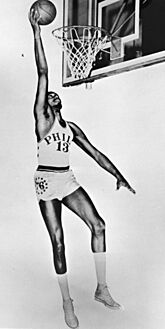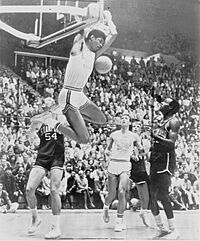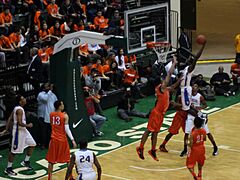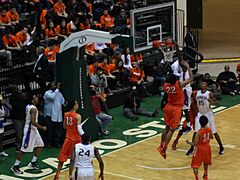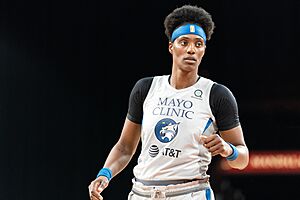Slam dunk facts for kids

A slam dunk, or just dunk, is a cool shot in basketball. It happens when a player jumps high, gets the ball above the basket, and then pushes it directly through the hoop with one or both hands. It's a type of field goal and is worth two points if it goes in. This shot was first called a "dunk shot." Later, a famous announcer for the Los Angeles Lakers, Chick Hearn, came up with the name "slam dunk."
Dunks are usually the easiest shots to make and they really get the crowd excited!
Did you know dunking was actually banned in college basketball (by the NCAA) from 1967 to 1976? Many people think this ban happened because of how dominant a college player named Lew Alcindor (who later became Kareem Abdul-Jabbar) was. That's why the no-dunking rule is sometimes called the "Lew Alcindor rule."
The phrase "slam dunk" has even become popular outside of basketball. In American English, it means something that is a "sure thing" – an action that is guaranteed to work, or a really impressive achievement.
Contents
How the Slam Dunk Started
The first time someone dunked the ball in a big game was in 1936. A player named Joe Fortenberry, playing for the McPherson Globe Refiners, did it in Madison Square Garden. A famous sports writer, Arthur Daley, wrote about it in The New York Times. He said Fortenberry and his teammate, Willard Schmidt, "pitch[ed] the ball downward into the hoop, much like a cafeteria customer dunking a roll in coffee."
In the 1940s, a tall player named Bob Kurland often dunked during games. But back then, defenders didn't like dunks. They saw it as an insult and would try to stop players from doing it, sometimes even hurting them. Another famous player, George Mikan, said, "We used to dunk in pregame practice, not in the game."
But things changed! By the 1950s and early 1960s, tall centers like Bill Russell and Wilt Chamberlain started dunking more often. Then, slightly shorter players like "Jumping" Johnny Green and Julius Erving in the 1960s and 70s also started dunking. This helped make the dunk a normal part of basketball today.
Rule Changes in the 1950s
In the 1950s, players like Jim Pollard and Wilt Chamberlain could even dunk from the free-throw line, which is 15 feet (about 4.5 meters) from the basket! Chamberlain could do it without a running start. This led to a rule change in 1956 by the NCAA. Now, a player shooting a free throw must keep both feet behind the line. Also, passing the ball over the backboard was banned because of Chamberlain.
A rule called "offensive goaltending" (or basket interference) was also added in 1956. This happened after Bill Russell used it a lot in college, and before Chamberlain started playing college basketball.
The "Lew Alcindor Rule" Explained
As mentioned, dunking was banned in college and high school sports from 1967 to 1976. Many people believe this was because of how dominant Lew Alcindor (now Kareem Abdul-Jabbar) was. That's why it's often called the "Lew Alcindor rule."
Some people also thought the ban might have been about race. At that time, many of the best dunkers in college basketball were African-American. The ban happened less than a year after a college championship game where an all-black team from Texas Western beat an all-white team from Kentucky.
How Breakaway Rims Changed the Game
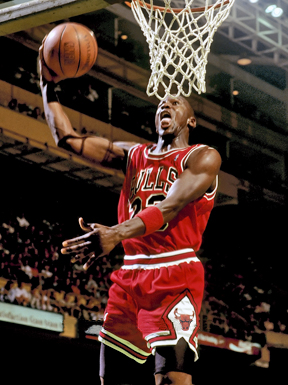
In 1976, a person named Arthur Erhat invented a special rim for basketball. This rim could bend a little when a player dunked but would snap right back into place. This made dunking much safer because it stopped the backboards from shattering. Before this, players like Gus Johnson and Darryl Dawkins had actually broken backboards with their powerful dunks!
In 1979, after Dawkins broke two backboards, the NBA quickly made a rule that breaking the backboard was a penalty. The new "breakaway rim" was introduced to the NBA in 1981. This invention helped bring the dunk back to college basketball too. Today, basketball equipment is much stronger to handle the powerful dunks of modern players.
The Era of Slam Dunk Contests
The very first Slam Dunk Contest was held on January 27, 1976. It was during halftime of the ABA All-Star Game. Julius Erving won that contest after jumping from the free-throw line!
The NBA started its own Slam Dunk Contest later. In the modern era, teams like the Houston Cougars (with Hakeem Olajuwon and Clyde Drexler) were known for their amazing dunks. They were even nicknamed "Phi Slama Jama."
Famous dunkers like Michael Jordan, nicknamed "Air Jordan," made the dunk even more popular. He performed a legendary dunk from the free-throw line in the 1988 contest. Another amazing moment was when Spud Webb, who was only 5 feet 7 inches tall, beat the much taller Dominique Wilkins in the 1986 contest!
In 1992, Shaquille O'Neal dunked so hard in games that he broke parts of the basket supports, though the glass didn't break. This led to even stronger backboard supports being built.
Dunks in the 2000s and Beyond
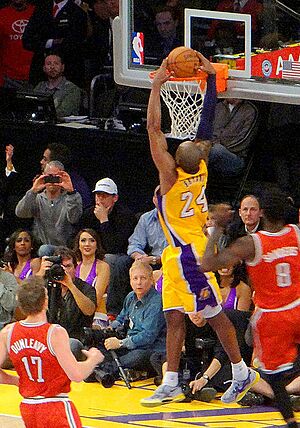
In the 2000 Summer Olympics, Vince Carter performed an incredible dunk where he leaped over a 7-foot-2 (2.18 m) French player. The French media called it "the dunk of death"! Carter also did amazing dunks in the 2000 dunk contest, like the "elbow hang" and a "reverse 360 windmill."
In the 2008 contest, Dwight Howard did his famous "Superman" dunk while wearing a cape. He jumped from inside the free-throw circle and threw the ball through the rim.
More recently, the Los Angeles Clippers team was nicknamed "Lob City" because of how often Chris Paul would throw "alley-oop" passes to teammates like Blake Griffin and DeAndre Jordan for dunks.
JaVale McGee holds a world record for the most dunks in a single jump: three! In the 2011 contest, he jumped with two balls and dunked each, then caught another pass for a third dunk.
In the 2016 contest, Zach LaVine did three different dunks from the free-throw line, all receiving perfect scores, and won the contest.
Different Kinds of Dunks
Dunk types show all the cool moves players do on their way to the basket. They range from simple one- or two-hand dunks to very athletic and tricky ones. Players can also combine different moves to create even more amazing dunks!
Tomahawk Dunk
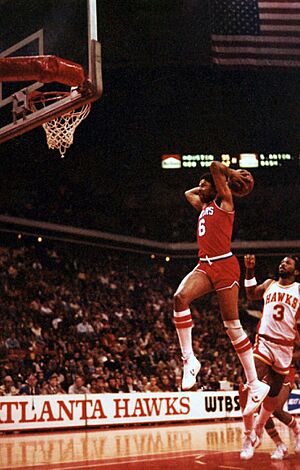
The "tomahawk" dunk is one of the simpler types. It looks like you're swinging a tomahawk axe. You can do it with one or two hands. If you use two hands, it's sometimes called a "backscratcher."
When you jump for a tomahawk, you raise the ball high above your head, sometimes even behind it, like you're winding up. Then you slam the ball down into the net at the highest point of your jump. Because it's not too hard to do, players of all sizes and jumping abilities use the tomahawk. The two-handed tomahawk is great for games because it helps you keep control of the ball. It's often used for "alley-oops" or when a player grabs an offensive rebound and dunks it right away.
A cool variation is doing a full 360-degree spin before or during the tomahawk.
Windmill Dunk
For a windmill dunk, before you jump or as you start, you bring the ball down to your stomach. Then, you swing your arm (or arms) in a big circle, usually from front to back, below your waist. Finally, you slam the ball through the rim. Many players can't hold the ball with just their palm through the whole swing, so they often finish the dunk with one hand.
There are many ways to do a windmill. You can do the circular motion with one arm and finish with one or two hands. Or, you can control the ball with both hands, swinging both arms in the windmill motion, and then finish with one or both hands. Sometimes, players "cuff" the ball between their hand and forearm. This gives them better control, allowing for a faster swing and more power when they dunk.
Dominique Wilkins was famous for his powerful windmills in games and contests. He did two-handed windmills, self-pass windmills, and even 360-degree windmills!
Double Clutch Dunk
When you jump for a double clutch, you hold the ball with one or both hands. Once you're in the air, you bring the ball to your chest. Then, you quickly push the ball downwards, extending your arms fully so the ball goes below your waist. Finally, you bring the ball back up above your head and dunk it with one or both hands. The whole move looks very smooth and fluid. To show off how high they can jump, players might hold the ball in the below-the-waist position for a tiny bit longer.
Often, players do the double clutch with their back facing the basket. But Spud Webb was known to do it while facing the basket! Players like Kenny "Sky" Walker and Tracy McGrady have even done 360-degree variations of the double clutch.
Between the Legs Dunk
This dunk is tricky! If you jump off one foot, you usually switch the ball to your non-dominant hand right before or as you take off. If you jump off two feet, you might wait a moment, keeping both hands on the ball so you don't drop it. Once you're in the air, you pass the ball from your non-dominant hand to your dominant hand, underneath a raised leg. Then, you bring the ball up with your dominant hand and slam it through the rim.
Isaiah Rider made the between-the-legs dunk famous in the 1994 NBA slam dunk contest. He called it "The East Bay Funk Dunk." Because it's so difficult, needing great hand-eye coordination, flexibility, and hang-time, it's usually only seen in dunk contests, not in regular games.
There are many variations of the between-the-legs dunk. For example, Jason Richardson has done it by passing the ball to himself off the backboard. One of the most amazing variations is combining it with a 360-degree spin. This is a crowd favorite because it requires incredible athleticism and hang-time. Zach LaVine did this dunk in the 2015 Slam Dunk Contest and called it the "Space Jam Dunk."
Elbow Hang Dunk
For an elbow hang, you jump like you would for a normal dunk. But instead of just dunking the ball, you push your forearm (or forearms) through the basket. You hook your elbow pit on the rim and hang there for a short time. Vince Carter introduced this dunk in the 2000 NBA Slam Dunk contest, but Kobe Bryant had been seen doing it earlier. People call this dunk by different names like 'honey dip' or 'cookie jar'.
In the 2011 NBA contest, Blake Griffin did an elbow hang after passing the ball to himself off the backboard. There are also even crazier versions, like the 'double-elbow hang' where a player puts both forearms through the rim and hangs.
Alley-oop Dunk
An alley-oop dunk happens when a player catches a pass while in the air and then dunks it. This move is used in both games and dunk contests. In games, if there are only a few seconds left on the clock, an alley-oop might be tried on an in-bounds pass. This is because the clock doesn't start counting down until a player touches the ball after it's thrown in.
Other Cool Dunks
Some players have done amazing things, like James White who performed tomahawk and windmill dunks while jumping from the free-throw line.
In the 2008 NBA Slam Dunk Contest, Jamario Moon jumped from the free-throw line, caught a bounce-pass from a teammate with his non-dominant hand, and dunked it.
A player named Taurian Fontenette, also known as Air Up There, has even performed a 720-degree dunk (two full turns in the air!) during a streetball game.
Dunking in Women's Basketball
Dunking is much less common in women's basketball compared to men's. While women might dunk more often in practice, many coaches advise against it in games. This is because there's a risk of injury or missing the shot.
In 1978, Cardte Hicks was the first woman to dunk in a professional game, though it was a men's game in the Netherlands.
In college, Georgeann Wells became the first woman to dunk in a women's collegiate game in 1984. She was 6 feet 7 inches tall. Ten years later, Charlotte Smith became the second.
As of 2024, at least 37 dunks have been scored by 8 different players in the WNBA. The first two were by Lisa Leslie in 2002 and 2005. Other WNBA players who have dunked include Michelle Snow, Candace Parker, Sylvia Fowles, Brittney Griner, Jonquel Jones, Elena Delle Donne, Liz Cambage, and Awak Kuier.
Brittney Griner holds the record for the most WNBA dunks, with 25 career dunks as of 2024. She was also the first player to dunk twice in one WNBA game and the first to dunk in a playoff game. Griner was also a huge dunker in high school and college, even dunking 52 times in one high school season!
At the 2012 London Olympics, Liz Cambage became the first woman to dunk in the Olympics.
Women in Dunk Contests
In 2004, when she was still in high school, Candace Parker was invited to a special event and won the slam dunk contest there! In later years, other women have also entered these contests. Brittney Griner wanted to join the McDonald's Dunk Contest in 2009 but couldn't because of her high school's attendance rules.
In the 2012 contest, Breanna Stewart, Alexis Prince, and Brittney Sykes competed. Stewart landed two dunks in the first round.
Images for kids
See also
 In Spanish: Slam dunk para niños
In Spanish: Slam dunk para niños


